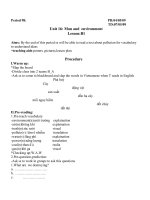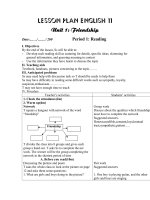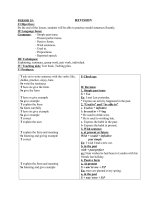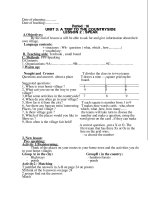the design thinking process will be examined to identify the issue and develop solutions to the organisational problem
Bạn đang xem bản rút gọn của tài liệu. Xem và tải ngay bản đầy đủ của tài liệu tại đây (1.36 MB, 21 trang )
TABLE OF CONTENTS
Table of Contents.................................................................................................................................1
1.
INTRODUCTION......................................................................................................................2
2.
EMPATHIZE AND DEFINE..................................................................................................3
A.
Identify............................................................................................................................................. 3
B.
Consequences.................................................................................................................................. 4
C.
Reasons............................................................................................................................................ 4
D.
Current Solutions........................................................................................................................... 5
Retention practices.............................................................................................................................................................................. 5
3.
IDEATE AND PROTOTYPE...................................................................................................6
A.
Using mind-mapping to generate creative solutions............................................................... 6
B.
Proposing solutions........................................................................................................................ 6
C.
How these solutions help to reduce job hopping...................................................................... 9
4.
PROTOTYPE AND TEST......................................................................................................11
5.
ETHICS AND SUSTAINABILITY......................................................................................13
A.
Users’ privacy............................................................................................................................... 13
B.
Users’ security.............................................................................................................................. 13
C.
VIP membership.......................................................................................................................... 13
6.
IMPLEMENTATION STAGE..............................................................................................14
7.
CONCLUSION.........................................................................................................................15
8.
REFERENCE LIST.....................................................................................................................16
1. INTRODUCTION
In the present circumstances, job hopping has been a pressing problem on the rise that occurs
frequently in most organisations. Hiring job hoppers is considered a drawback for most
organisations, since the employee commitment and loyalty become uncertain (Darmody
2019).
In this report, the design thinking process will be examined to identify the issue and develop
solutions to the organisational problem. The design thinking helps organisations understand
the worker needs and solve their problems rationally with complementary approaches (Foster
2019). The design thinking consists of 6 stages including empathise, define, ideate, prototype,
test, and implement. In the first two stages, empathizing with job hoppers and identifying this
pressing issue using several research will be analyzed. Next, possible assumptions and
solutions will be brainstormed in the ideate and prototype phase. In the next two stages, a
prototype of solutions will be discussed and tested. Ethics and sustainability will also be
mentioned. Lastly, resources, actions, and activities will be included in the implementation
plan to transform vision into action (Dunne 2018).
2. EMPATHIZE AND DEFINE
A. IDENTIFY
Job hopping is an existing organizational problem which refers to the tendency of someone to
work in a specific organisation for a short period of time (less than two years) (Pandey 2019).
Specified in prior research, mainly young employees including Millennials (born between
1977 and 1995) and Generation Z (born between 1996 and 2015) are found to change jobs
frequently (Subin 2021). 21% of Millennials reported that they have changed jobs in 2018 in
a Gallup report, “which is more than three times the number of non-millennials who report
the same” (Pasch, 2019). Furthermore, Fry (2017) declared that Generation X are even job
hopping faster than Millennials.
Any ambitious employee will naturally have a hard time considering staying loyal to the
current organisation or leaving for new career opportunities (Hernandez 2018). Consequently,
during this empathise stage, organisations need to spend time observing and engaging with
their employees through interviews and surveys, to have a better understanding of their
employee needs and to implement improvements in their management.
B. CONSEQUENCES
Employees' decision to change their jobs frequently limits the company growth and costs the
organization additional expenses. Such an act might cost the company the ability to strive for
its potential and affect them in the long run against their competitors. For instance,
recruitment costs include advertising, referral, and agency costs. After the recruitment
process, managers also need to interview their prospective candidates, put out training costs,
and set up an orientation for newcomers.
Contrarily, job-hopping may appear beneficial to workers and is currently favoured by most
of them. The transfer to a new organization allows employees to gain new professional
networks, different experiences, more opportunities to move up the cooperative ladder.
However, occasionally hopping to different fields may also brings out numerous
disadvantages to their career (Arunsunai 2020). Employers are not likely to hire a job hopper
since employees cannot guarantee a secure job for themselves. The job-hopper is likely to
feel unsatisfied with whatever job that they applied to, and the manager might feel like the
job-hopper might leave the company anytime (Larasati & Aryanto 2020).
C. REASONS
According to Leidner and Smith (2013), spending a lifetime at an organization might not fit
in this current fast-paced economy. As specified by the Bureau of Labor Statistics (Chalabi
2014), the average tenure of employees aged 18 to 34 at one specific company is less than 3.2
years.
There are many prominent reasons for employees to switch their jobs which include
opportunities to earn higher wages, gain more career growth, and work in a better-quality
management system (Byriel 2021). For evidence, employees were reported to receive a 1020% increase in salary as they leave their company to work at a different one (Keng 2014).
Thereby, their skills and financial state tend to grow at a much faster rate due to the increase
in their salaries (Goswami 2020).
D. CURRENT SOLUTIONS
As stated above, Millennials and Gen Z were found to stay and work at one company for a
short period of time. The old norm of 20 to 30 years working for one has become a thing of
the past (The Associated Press 2016).
RETENTION PRACTICES
Today, organizations are resorting to methods that can help them retain employees and
thwart job-hopping efforts by providing more attractive work, development, and
promotion opportunities. For example, organizations have specific flexible working
policies for employees (Rousseau & Shperling 2003). As retention and relatively higher
salaries have a direct link (Batt 2002), companies should discuss how worthwhile the
salary and promotion policies correspond with employees’ qualifications. Additionally,
offering employees opportunities to develop their skills is an effective solution (Batt
2002), since employees tend to look for another company if their career is not progressing.
Therefore, managers should assure employees that their work will make a difference to the
organization. Offering employees professional development opportunities such as soft
skills or technical skills can increase engagement and improve company retention (Forbes
Human Resources Council 2020).
This is a matter of both the business and the employee. Existing solutions are only used by
businesses to retain employees without a comprehensive solution for employees. They
may want to change jobs not because the company is not good, but because they do not
feel satisfied with themselves.
3. IDEATE AND PROTOTYPE
A. USING MIND-MAPPING TO GENERATE CREATIVE SOLUTIONS
Mind-mapping developed by Tony Buzan is a powerful tool that explores the thoughts the
brain has on a topic from different perspectives by activating the right and left lobes of the
brain together as an alternative to linear thinking (Erdem 2017). It also captures the user’s
free flow of ideas using diagrams during brainstorming (Creately 2021). Mind-mapping has
an important role in learning and working as it becomes a lifelong learning tool (Erdem
2017). Every brain works differently so different people think differently (Woods 2009).
Therefore, mind-mapping is suitable for group work as everyone can contribute ideas.
Subsequently, ideas can be broken down, compared and analyzed to find out the best
solutions.
We first individually researched possible reasons for job-hopping in Millennials and Gen Z
before the meeting to identify the problem and discuss how it will be solved. Secondly,
throughout the online meeting, all members shared the MindMeister mind map tool and set a
30-minute limit generate their unique ideas freely. After that, we reviewed, evaluated, and
combined all ideas to develop the optimal solution. In the end, the ideas that got the most
votes from everyone would become our final solution.
B. PROPOSING SOLUTIONS
As mentioned above, job hopping is not only disadvantageous for employees, but also for
organizations because of cost recruitment, onboarding, and training. Hence, job hopping is
the pressing issue that needs to be solved. Consequently, a variety of solutions were brought
up and each was eliminated by considering the effects to reach a final decision.
Link to Mindmeister: Mindmeister
C. HOW THESE SOLUTIONS HELP TO REDUCE JOB HOPPING
Through analysis, our group found various fun ideas to reduce job-hopping. Those ideas
include making the workplace more fun by arranging parties, placing pottery workshops or
clay-making stations, and organizing unique contests to encourage positivity in employees'
mindsets. Besides, offering employees opportunities to work abroad can let them know that
their capabilities and skills are trusted. Moreover, producing podcasting in various industries,
advice on how workers can update their skills is also practical solutions. However, these
solutions need to come through various elements to cope with the core problems thoroughly.
For instance, it depends on organizational structure, costs, infrastructure, and type of
business. Therefore, encouraging employee interactivity, engagement, and communication by
joining business networking site applications is the final decision.
Millennials and Generation Z are identified as heavy users of social networking platforms
(Chen et al. 2021; Kastenholz 2021). By integrating text messaging, socializing, and social
media sites such as Twitter and LinkedIn, organizations can boost innovation capabilities for
Millennial and Gen Z collaboration (Benson 2016 & Lavalley 2019). Accordingly, our
group's next solution is to implement an app called "U-DECIDE" that assists employees to
look for a career associated well with their strengths, interests, better compensation, and
opportunities to move into a desirable position.
To understand their preferences, the user is suggested to do a multiple-choice test that
questions about their career goals after logging in. Our application relies on AI and machine
learning recommendation tools that combine content-based filtering and collaborative
filtering (Dwivedi 2020). The systems narrow down users' selections and create a targeted
resume to highlight their best skills and accomplishments, thereby listing jobs in the
Recommend Companies section (Williams 2018).
Furthermore, job hoppers will not feel incompetent and unworthy since they can
anonymously share their confessions through Confession. The section increases the network
or community atmosphere chances; thus, they can also learn from the struggles and mistakes
of others and prevent them from making the same ones.
Besides, the Reviews section in our application helps job-hoppers stay updated. It allows
users to upload and share their expertise with other professionals in their industry, which
helps others find an inside track into jobs they may be qualified for but have never heard
about. For example, which industries are hiring, or which skills are currently in demand.
Sypniewska (2014) proposed that job satisfaction consists of five motivating factors: verbal
acknowledgment, progress, arduous task, accountability, and achievement. Hence, through
the Achievement section, employees can see what they have achieved throughout the work
performance. Employees will have a more optimistic mindset when their work is recognized,
which increases the chance to remain with the organization (Shah 2019).
Besides, the Achievement section highlights their milestones beyond award. Our group
believes that this can somehow reduce the impulsiveness in decision-making that may
manifest in some employees as a form of anxiety that causes poor work-life balance and
preventing them from advancing their careers (Steenackers & Guerry 2016; Martin & Potts
2009).
4. PROTOTYPE AND TEST
At first, the user has to sign in
Secondly, three options for the
with the code.
user to choose are wanting to change your
current job, wanting to review
companies, and others.
Moving to this step, the user can
choose one of four functions to use.
About ‘achievement’, the user can reflect on
their successes since they started to work.
Next, ‘quick test’ helps consumers get
With ‘confession’, users can acquire and
the nomination for the job that matches
share the knowledge and as well as the difficulties
their requirements.
they are facing.
‘Review’ function helps consumers
state their point of view about the
company they have been working at.
‘Recommendation companies’ offers users a variety
of suitable jobs through ‘quick test’.
5. ETHICS AND SUSTAINABILITY
During the creation of the app's prototype, three ethical and sustainability-related concerns
emerged: user privacy, user security and VIP membership. Companies operate ethically by
defining objectives, tasks, and managing them appropriately (Elms et al. 2020).
A. USERS’ PRIVACY
Protecting each user's personal information is extremely essential to prevent others from
logging into your personal account, information inequality, unfair and discriminatory
information (Hoven et al. 2019). To avoid disclosure of information to the outside, 'UDECIDE' will request to login with the code provided through the user's phone number.
When users encounter logging problems, they can contact the IT group for assistance.
B. USERS’ SECURITY
The 'U-DECIDE' application was created for employees to switch jobs less, particularly those
in today's young class. However, there are several negative consequences for users. Some
people utilize chatting on the app to defraud others using ‘the depiction of deceptive message
production’ to obtain users' sensitive information (Burgoon 2015). As a result, the 'chat box'
function has not been applied on 'U-DECIDE' as users cannot put their full trust into this app.
C. VIP MEMBERSHIP
Users can upgrade to receive more incentives like being consulted by the task-oriented
psychologists. Job orientation is considered a continuous process and a vital part in every
organization (Rabha 2021). However, when not properly guided, employees can be put under
pressure easily due to their tasks. As a registered member, VIP users can get free support on
matters of work and psychological counselling because of the heavy workload.
6. IMPLEMENTATION STAGE
Our implementation plan is estimated to be a 4-month plan, consisting of 6 activities
including budget plan, content building, development & design, resources (hiring
employees), testing & adjustment, and marketing. Among them, we anticipate that content
building would be the most interesting process since this is driven by collaboration between
psychologists and content builders.
7. CONCLUSION
In conclusion, job hopping could cause a negative impact on employee careers but also
massive costs for organizations. Accordingly, applying Design Thinking methodology, the
paper has written an in-depth analysis of job hopping which is the problem on the rise.
Through 6 stages, the most creative and practical solution has been established, introducing
an application by the name of “U-DECIDE”. This app, targeting potential job hoppers, helps
them realize who they are and keep motivated with various features. Although three ethical
issues have arisen in the Test stage, they have successfully been prevented. Lastly, activities
in the implementation plan are conducted for 4 months.
8. REFERENCE LIST
Arunsunai, M 2020, Are Job-Hopping bad for your Career?, LinkedIn, viewed 24 August
2021, < />Batt, R 2002, ‘Managing Customer Services: Human Resource Practices, Quit Rates, and
Sales Growth’, The Academy of Management Journal, vol. 45, no. 3, pp. 587-597.
Benson, T 2016, ‘Motivating Millennials Takes More than Flexible Work Policies’, Harvard
Business Review, 11 Feb, viewed 26 Aug 2021, < />Burgoon, JK 2015, ‘When is Deceptive Message Production More Effortful than TruthTelling? A Baker’s Dozen of Moderators’, Frontiers in Psychology, vol. 6, pp. 1-9.
Byriel, E 2021, Millennials Don't Want to Job Hop, But Here's Why They Do, Keyot, viewed
26 August 2021, < />Chalabi, M 2014, ‘Dear Mona, I’ve Been in My Job For 3 Years. Am I Normal?’,
FiveThirtyEight, 27 Jun, viewed 26 Aug 2021, < />Chen, F, Cheng, L & Park, G 2021, ‘A Study on the Millennials Usage Behavior of Social
Network Services: Effects of Motivation, Density, and Centrality on Continuous Intention to
Use’, Sustainability (Basel, Switzerland), vol. 13, no. 5, p. 2680, ProQuest database.
Creately 2021, Brainstorming Techniques to Visually Generate Ideas for Teams, Creately,
viewed 27 August 2021, < />Darmody, J 2019, 'Why do employers still see job-hopping as a bad thing?', Silicon Republic,
17 January, viewed 24 August 2021, < />DeVaro, J & Fan, X 2020, ‘Job Hopping and Adverse Selection in the Labor Market’,
Journal of law, economics, & organization, vol. 36, no. 1, pp. 84–138.
Dunne, D 2018, 'Implementing design thinking in organizations: an exploratory study',
Journal of Organization Design, vol. 7, no. 16, pp. 1-16.
Dwivedi, R 2020, ‘What Are Recommendation Systems in Machine Learning?’,
Analyticsteps, 19 Jan, viewed 26 Aug 2021, < />Eightfold 2020, ‘How to Attract and Retain Talent in a Job-Hopping Market’, Eightfold, blog
post, 25 February, viewed 27 August 2021, < />Elms, H, Nolan, J, Werhane PH & Wicks, AC 2020, ‘Spheres of Influence: A Walzerian
Approach to Business Ethics’, Journal of Business Ethics, pp. 1-14.
Erdem, A 2017, ‘Mind Maps as a Lifelong Learning Tool’, Universal Journal of Educational
Research, vol. 5, no. 12A, pp. 1-17.
Forbes Human Resources Council 2020, ‘10 Proven Methods To Support The Development
Of Soft Skills In Your Employees’, Forbes, 14 February, viewed 26 August 2021,
<humanresourcescouncil/2020/02/14/10-proven-methods-to-support-the-development-ofsoft-skills-in-your-employees/?sh=2fdc096263cd>.
Foster, KM 2019, 'Design Thinking: A Creative Approach to Problem Solving', Management
Teaching Review, vol. 6, no. 2, pp. 1-34.
Fry, R 2017, Millennials aren’t job-hopping any faster than Generation X did, Pew Research
Center, viewed 26 August 2021, < />Goswami, A 2020, Job hopping: A boost for career growth?, HRKatha, viewed 31 August
2021, < />Hartung, R 2014, ‘How job hopping hurts productivity’, TODAYonline, 26 August, viewed on
27 August 2021, < />Hernandez, J 2018, Company Loyalty or Job Hopping? – Deciding Whether You Should Stay
or Go When Trying to Advance Your Career, LinkedIn, viewed 26 August 2021,
< />Hoven, JVD, Blaauw, M Pieters, W & Waniers, M 2019, ‘Privacy and Information
Technology’, in EN Zelta (ed.), Stanford Encyclopedia of Philosophy, viewed 27 August
2021, < />HR in ASIA 2019, How HR Professionals Help Avoid Job Hopping, HR in ASIA, viewed 28
August 2021, < />Kastenholz, C 2021, ‘Gen Z And The Rise Of Social Commerce’, Forbes, 17 May, viewed 24
Aug 2021, < />Keng, C 2014, Employees Who Stay In Companies Longer Than Two Years Get Paid 50%
Less, Forbes, 22 June, viewed 31 August 2021,
< />Larasati, MA & Aryanto, D 2020, ‘Job-hopping and the Determinant Factors’, Proceedings of
the 5th ASEAN Conference on Psychology, Counselling, and Humanities (ACPCH 2019),
pp. 54-56.
Lastoe, S n.d., 3 Fears Hiring Managers Have About Job Hoppers That You Can Put to Rest,
The Muse, viewed 27 August 2021, < />Lavalley, AL 2019, Reshaping the workplace, Professional Roofing, viewed 26 Aug 2021,
< />Leidner, S & Smith, MS 2013, ‘Keeping potential job-hoppers’ feet on the ground’, Human
Resource Management International Digest, vol. 21, no. 1, pp. 31-33.
Martin, LE & Potts, GF 2009, ‘Impulsivity in decision-making: An event-related potential
investigation’, Personality and individual differences, vol. 46, no. 3, pp. 303–308.
Pandey, DL 2019, ‘Job Hopping Tendency in Millenials’, NCC Journal, vol. 4, no. 1, pp. 4146.
Pasch, MH 2019, ‘Stop Blaming Millennials: Job Hopping Explained’, Gloat, blog post, 2
June, viewed 26 August 2021, < />Polog, I 2019, The UK’s job hopping habits, Training Journal, viewed 27 August 2021,
< />Rabha, M 2021, ‘Workplace Orientation: What Does it Mean and its Purpose’, Vantage
Circle Blog, blog post, 19 May, viewed 27 August 2021,
< />Rousseau, DM & Shperling Z 2003, ‘Pieces of the action: Ownership and the changing
employment relationship’, The Academy of Management Review, vol. 28, no. 4, pp. 553–570.
Shah, D 2019, ‘How to Adopt an Optimistic Mindset’, FDM, 11 March, viewed 24 Aug 2021,
< />Stamp, B 2018, ‘How to Prevent Job-Hopping From Overtaking Your Team’, Glass Door,
blog post, 14 December, viewed 27 August 2021,
< />Steenackers, K & Guerry, MA 2016, ‘Determinants of job-hopping: an empirical study in
Belgium’, International journal of manpower, vol. 37, no. 3, pp. 494–510.
Subin, S 2021, ‘Millennials, Gen Z are job-hopping, but contrary to popular belief, maybe not
enough’, CNBC, 28 February, viewed 26 August 2021,
< />Sypniewska, BA 2014, ‘Evaluation of Factors Influencing Job Satisfaction’, Contemporary
economics, vol. 8, no. 1, p. 57–72.
The Associated Press 2016, ‘Here’s Why Your Parents Stayed at the Same Job for 20 Years’,
Fortune, 11 May, viewed 26 August 2021, < />
Walden University n.d., ‘How HR Managers Can Help Reduce Job Hopping’, Walden
University, viewed 25 Aug 2021, < />Williams, J 2018, ‘How do Job Recommendation Engines Work’, JobsPikr, 3 August, viewed
26 Aug 2021, < />Woods, D 2009, The Power of Mind Mapping, Forbes, 9 June, viewed 27 Aug 2021,
< />Zainotdini, A 2020, ‘The Job-Hopping Fad: Why & How Employers Can Stop It’,
Employment and Employability Institute, blog post, 27 February, viewed 27 August 2021,
< />Zimmerman, K 2019, Here’s How Employers Can Prevent Their Employees From Job
Hopping, Forbes, 5 May, viewed 27 August 2021,
< />









